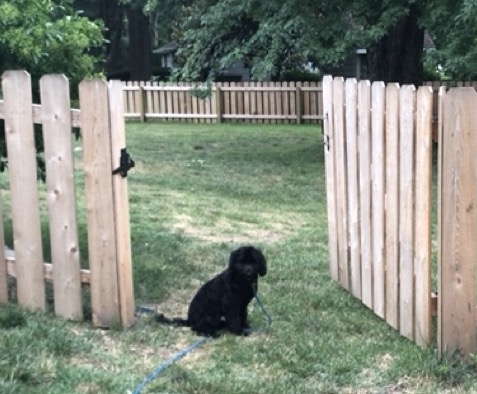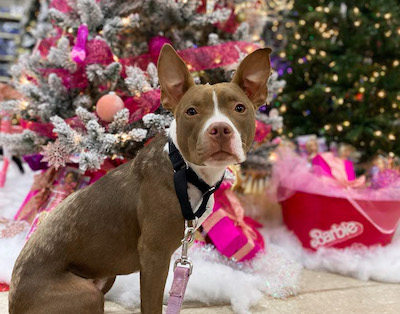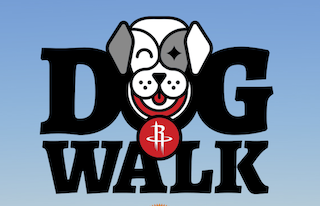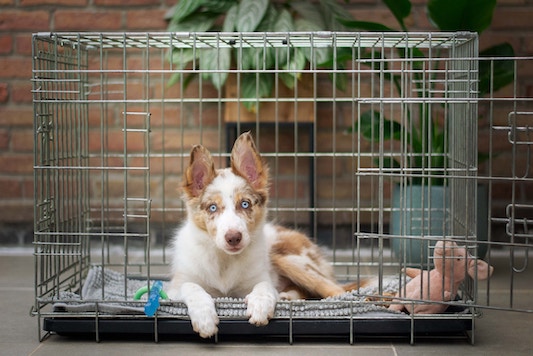Puppies, being the curious creatures they are, tend to lack impulse control. Wait is a fantastic skill to teach your puppy. It will not only help improve their impulse control, but it will also discourage your puppy from running out of doors, running away from you, and can be a helpful tool for dogs who engage in barking or chasing dogs or other small animals as they grow into adulthood. We recommend teaching the wait command early and using it often as part of your daily routine.
What you will need:
- A 50 ft long line
- A fitted collar
- Treat bag
- Treats or kibble
Teaching a threshold wait:

It is easiest to teach wait by starting at a threshold. We recommend using a door first. For safety, double check that your puppy’s collar is fitted correctly, nice and snug, and will not slip over their head if they pull on the long line. Position your treat pouch on your back, out of sight.
- Start inside with the door closed, holding the long line with around 1 ft of slack. Stand near the door so that when you open it, you can place your back against the door.
- Crack the door open. If your puppy does not move forward, say “good” and toss a treat away from the door.
- If your puppy does move forward towards the opening, quickly close the door. You may need to open and close the door quickly multiple times. The first moment you crack the door open and your puppy does not move forward, say “good” and immediately toss a treat.
- Once your puppy is successfully not moving forward with the door cracked, begin to open the door wider. Once the door is open, you will want to place your back against the door. You will bridge “good” and toss a treat when the door is at its widest point.
- If your puppy tries to run past you, extend your leg out in front of them to block them and say “uhuhuh”. If they get past you, correct them by using the long line and bringing them back inside. Close the door and try again.
- Increase how long your puppy can maintain the wait command starting with 5 seconds. If your puppy is successful, say “good” and toss a treat. For them to be allowed to cross the threshold, they need to wait until you have said, “free”. Work up to 30 seconds.
Increasing difficulty and distractions:
Once your puppy has learned to wait at the door, you can now begin to add in distractions such as walking out of the door or making noises.
- Prompt your puppy to wait, and continue to bridge “good” and toss a treat when they are successful. Then, you will take a step outside of the door. Your puppy can move around as long as they do not cross the threshold. When you step outside, if they remain behind the threshold, bridge “good” and toss a treat behind them. When you are ready to release them, say “free”.
- You can begin to add in additional distractions, such as allowing more slack in the line and walking 5 feet away from them. Always bridge and feed when it is most difficult for them or when adding in a new distraction. For example, when you walk to the 5 feet mark, bridge “good” and toss a treat inside the door. Try to add in additional distractions such as a “kissy” noise, or patting your leg. As soon as you pat your leg or make a noise, bridge “good” and toss a treat. You can add in a “wait” reminder at difficult distractions to start. Fade additional reminder prompts out as your puppy is successful.
- If your puppy crosses the threshold while you are outside, say “uhuhuh” and use your body to quickly move towards them and body block them back into the doorway behind the threshold. Repeat again until successful.
- Try to incorporate 3 distractions into your wait routine. When you are ready, you can say “free” and your puppy can come outside past the threshold. Do not feed for “free”.
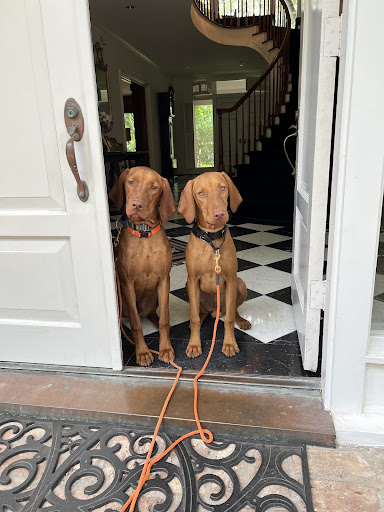
Additional Training Tips:
- If your puppy is testing the threshold boundary and stepping on it, tap their toes to encourage them to step back behind the threshold.
- If you are trying to add a distraction and your puppy has failed more than 3 times, increase how quickly you are feeding or decrease the difficulty of the distraction by moving in closer or lowering the volume or intensity of your prompt.
- Remember the The 5 D’s: distance, duration, distraction, direction, and disappearing. You can increase or decrease the difficulty of these to improve compliance or make the command more challenging for your puppy.
- If your puppy is nervous with the body block corrections, you can decrease the intensity and increase how often you toss a treat to reinforce them not breaking the threshold.
- If your puppy is struggling with “free”, encourage them to cross by gently coaxing them by using a small amount of tension on the lead.
Once your puppy understands the concept of “wait,” you can begin to teach the wait command in other relevant areas such as the stairs, car doors, entryways, and even outside! If after teaching, you are still struggling with a puppy who engages in dangerous behaviors such as bolting out of the door or running away from you, we recommend contacting your local behavior consultant.
